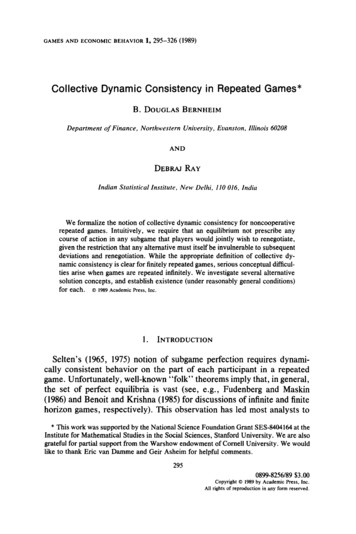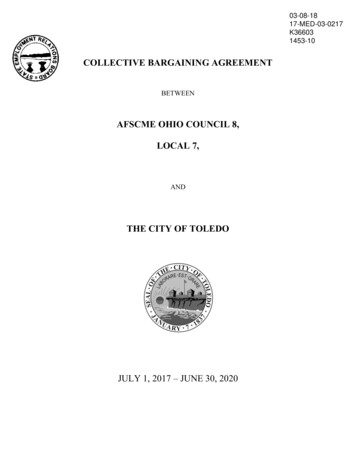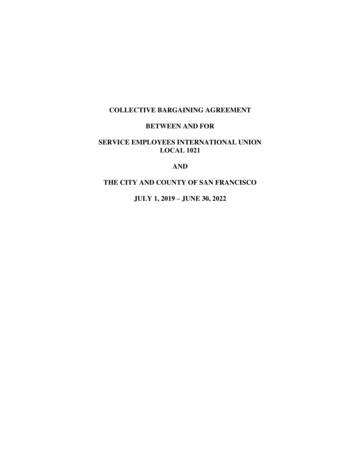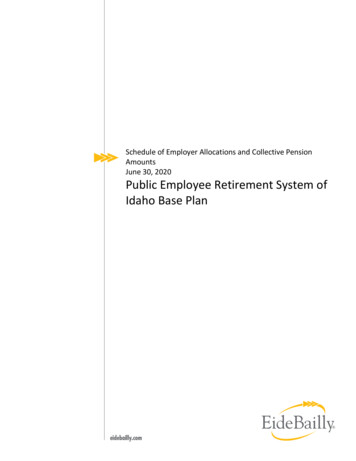
Transcription
GAMESANDECONOMICBEHAVIOR(1989)1,295-326Collective Dynamic Consistency in Repeated Games*B. DOUGLASDepartmentBERNHEIMof Finance, NorthwesternUniversity, Evanston, Illinois 60208ANDDEBRAJRAYIndian Statistical Institute, New Delhi, 110 016, IndiaWe formalize the notion of collective dynamic consistency for noncooperativerepeated games. Intuitively, we require that an equilibrium not prescribe anycourse of action in any subgame that players would jointly wish to renegotiate,given the restriction that any alternative must itself be invulnerable to subsequentdeviations and renegotiation. While the appropriate definition of collective dynamic consistency is clear for finitely repeated games, serious conceptual difliculties arise when games are repeated infinitely. We investigate several alternativesolution concepts, and establish existence (under reasonably general conditions)for each. 0 1989 Academic Press, Inc.1. INTRODUCTIONSelten’s (1965, 1975) notion of subgame perfection requires dynamically consistent behavior on the part of each participant in a repeatedgame. Unfortunately, well-known “folk” theorems imply that, in general,the set of perfect equilibria is vast (see, e.g., Fudenberg and Maskin(1986) and Benoit and Krishna (1985) for discussions of infinite and finitehorizon games, respectively). This observation has led most analysts to* This work was supported by the National Science Foundation Grant SES-8404164 at theInstitute for Mathematical Studies in the Social Sciences, Stanford University. We are alsograteful for partial support from the Warshow endowment of Cornell University. We wouldlike to thank Eric van Damme and Geir Asheim for helpful comments.2950899-8256/89 3.00Copyright 0 1989 by Academic Press, Inc.All rights of reproduction in any form reserved.
296BERNHEIMANDRAYimpose additional refinements in specific applications. The most commonpractice is to consider “cooperative”equilibria-thosethat are Paretoefficient within the class of perfect equilibria. In imposing this furtherrefinement, one implicitly assumes a kind of collective rationality. Specifically, if players bargain with complete information over possible outcomes subject to any set of constraints, one normally assumes that allfeasible Pareto improvementsare made. In noncooperativeenvironments, the relevant constraints are incentive compatibility and individualdynamic consistency-thefeasible set is defined by agreements that areself-enforcing both on and off the equilibrium path. Thus, it appears natural to study the most collusive perfect equilibria.Unfortunately,this practice lacks internal consistency. Players typically have the opportunity to reexamine their self-enforcing agreement atany point during the course of play. Just as we require dynamically consistent behavior on the part of each individual, it is then essential to insistupon dynamic consistency at the collective level. For purposes of illustration, consider the one-shot game illustrated in Table I. There are twoNash equilibria (ui2, a ) and (a i3, a&. Since the first Pareto dominatesthe second, we would expect players to opt only for the first as a selfenforcing agreement. Now consider a single repetition of this game, andassume for simplicity that there is no discounting. In the two-stage game,there is a perfect equilibrium in which players cooperate (play (air, uzr))initially, and then play (an, u2*) in the terminal period, with any firstperiod deviation punished by reversion to (an, a&. Yet each playerknows that if either actually deviated in period 1, each would have anincentive post hoc to renegotiate the original agreement, and play (an,uz2) instead. If players actually have the opportunity to discuss strategiesTABLEIILLUSTRATION OFCOLLECTIVE o2.2o,oa130.0o,ol,l
COLLECTIVEDYNAMICCONSISTENCY297at each stage, then it seems natural to rule out the cooperative equilibrium, on the grounds that it entails dynamically inconsistent behavior atthe collective level.Collective dynamic consistency might well rule out many equilibriacommonly considered by applied game theorists. For example, grim strategies typically make all players strictly worse off relative to the equilibriawhich they support. On the other hand, collective dynamic consistencyneed not rule out cooperation: for instance, Rubinstein’s (1979) notion ofa strong perfect equilibrium is not vulnerable to renegotiation, and it isknown that certain games admit cooperation as strong perfect equilibria.Unfortunately,Rubinstein’s notion is more demanding than necessary forthe purpose of imposing collective dynamic consistency, and as a resultoften fails to exist.In this paper, we define and investigate several notions of collectivedynamic consistency for repeated games. After describing an analyticalframework and notation in Section 2, we consider finitely repeated gamesin Section 3. Intuitively,our concept requires that an equilibrium notprescribe any course of action in any subgame that players would jointlywish to renegotiate (given the restriction that any alternatives must themselves be invulnerable to subsequent renegotiation). This intuition suggests a recursive definition of the refinement. However, for infinitelyrepeated games, the recursive approach is invalid. Indeed, defining collective dynamic consistency becomes problematic. In Section 4, we discuss these difficulties, propose a specific notion of consistency, and demonstrate existence under relatively general conditions. In Section 5, wenote that our formulation of consistency might rule out some apparentlyattractive equilibria, and it might fail to rule out some unattractive ones.We therefore propose two alternative refinements--minimalconsistencyand simple consistency-thatyield more satisfactory results in the casesconsidered. We also establish existence under relatively general conditions. Section 6 contains a simple example, in which the requirement ofcollective dynamic consistency isolates interesting subsets of perfectequilibria. Section 7 describes the relationship between this paper andother work on renegotiation in noncooperative environments.2.2.1.PRELIMINARIESOne-Shot GamesConsider a one-shot simultaneous move game. The player set is N (1, * - - , n}. For i E N, Ai is the action set of player i. This correspondsto player i’s strategies in the one-shot game. Write A XiENAi. An actionfor player i is a choice ai E Ai. Write a (al, . . . , a,) (so a E A). The
298BERNHEIMAND RAYpayoff function of i is a real valued functionG e {(Ai)iEN’(nii)iEN} is the one-shot game.We make the following assumptions on G.(A.l)(A.2)(A.3)2.2.7 on A. The collectionAi is compact for each i E N7ri: A !I? is continuous for each i E NG has a Nash equilibrium in pure strategies.’RepeatedGamesWe shall now repeat the game G for time periods 0, . . . , T. T is thehorizon. It may be finite or infinite, respectively giving rise to a finitelyrepeated game or an infinitely repeated game.Suppose that player i, i E N, has a discount factor & E (0, 1). Wedenote by GT the game formed by playing G during periods 0, . . . , T,and writing payoffs as a discounted sum of one-shot payoffs. More precisely, for any action profile (Y (a,) , where a, E A, the payoff to player iis evaluated by the expressionII,(a) c i 6fTi(U[).t oObserve that II,(a) can be viewedof all action profiles AT, continuousgence .A t-history h, is defined for anyprevious actions. A typical t-historyas a real valued function on the spacein the topology of pointwise convert 1, . . . , T as the sequence ofis of the formh, (ao, . . . , a,- ),t l,. .,TClearly, A’ is the set of all possible t-histories. A history h is a sequence oft-histories: h (hl, hz, h,, . . . .A strategy for player i is a sequence of functions i (Jlil): such thatt,bir: A’ * Ai,121’ We are using the interpretation that the elements of Ai are actions involving no randomization. Of course, we could just as well think of these elements as mixed strategies, thoughthe interpretation of this in a repeated situation is somewhat forced.
COLLECTIVE DYNAMIC CONSISTENCY299Let Vjr be the set of ah strategies for i, and define qr 5 97. WriteJi 3 ( i)iEN E qT. We shall call 9 a strategy profile.Given 9 E 9r, let a( ) be the action profile induced (in the obviousway) by I/I. More generally, define for any J, and t-history ht, at(JI, h,) asthe action profile (a,, . . . , uT) starting from time t and induced by the thistory h, and a subsequent application of 9. When T CQ,this can beidentified easily with an action profile (a:): starting from t 0, by puttingal a,,, for all s B 0. When T ai, we shall omit the superscript Ton Vr.Throughout, we will use the notation that for any n-tuple (x1, . . . , x,),X-; denotes the (n - l)-tuple ( 1, . . . , xi-i, xi r, . . . , x,).3.CONSISTENT EQUILIBRIA IN FINITELY REPEATED GAMESOur analysis of finitely repeated games makes use of some additionalnotation. For each a , denote discounted payoffs asIl (CX’) 2r ,67-‘7Ti(177).For each 4 E ?r, t such that 0 t I T, and t-history hl, letVi( ) nP(4 ))anduf(9, h,) W(d , M).The strategy profile I* E ‘PT is a subgame perfect Nash equilibrium(abbreviated PE) if for each i, t, and t-history h,, we haveanduf(t,//*, h,) 2 U:( i, Jlfi, ht)for all i E 9:.We define a consistent equilibrium by induction on the number of stagesin the game. For T 0, let %O be the set of I* E q” such that, for all iand i E 97,Vi( *)zVi( ivJI*i)*
300BERNHEIMANDRAYTo is simply the set of Nash equilibria in the one-shot game. Next, definethe consistent equilibrium set @Oas * E To such that for all J E To,Vi( * 2Vi( )for some i. @Ois simply the weak Pareto frontier of the Nash set. Intuitively, in a one-shot game players would always renegotiate to the Paretofrontier of the set of self-enforcing agreements. Clearly, assumptions(A.l) through (A.3) guarantee that @Ois nonempty.Now consider the t-stage game. Define the set Fr as * E ?’ such thatfor all i and i E ‘Pf,and, for all hl, (I/ (*, hi)): i E et-i. Intuitively, we have already definedthe consistent set @f-1, and must require that all continuation strategyprofiles lie in this set, or players would renegotiate upon reaching period1. Finally, define the consistent set et as * E g’ such that for all I/JE vr,V;( *) Vi( )for some i. That is, we look at the Pareto frontier of vr-otherwise,players would renegotiate in period 0. Once again, existence follows in astraightforward way from (A. 1) through (A.3).It is immediate from definitions that every consistent equilibrium issubgame perfect, but not vice versa. It is, for example, clear that the gameconsidered in the introduction (Table I) has only one consistent equilibrium, in which no cooperation occurs.The notion of a consistent equilibrium for finitely repeated games wasdeveloped in an earlier draft of this paper (Bernheim and Ray, 1985). Theconcept also appears under different names in van Damme (1987) andFarrell and Maskin (1987). Bernheim et al. (1987) noted that this notionmay not be entirely satisfactory for games involving more than two players, in that we have restricted attention to renegotiation by the set of allplayers. Their notion of a perfectly coalition proof equilibrium coincideswith consistency in two-player, finite horizon games. Bernheim andWhinston (1987) provided an example in which consistency isolates subgame perfect equilibria of particular interest (the equilibria are cyclical,despite the fact that the game also admits noncyclical subgame perfectequilibria). Bernheim and Ray (1987) described a more elaborate examplealong these -lines in an economic context. More recently, Benoit andKrishna (1988) provided an analysis of the behavior of consistent equilibrium payoffs in an undiscounted, finitely repeated game, as the horizon
COLLECTIVEtends to infinity. (Their refinement is slightlyPareto frontier.)While the definition of collective dynamicpeated games is not controversial (at least forextension to infinitely repeated games hasremaining sections, we focus exclusively rent in the choice of theconsistency for finitely regames with two players), itsproven problematic. In theinfinitely repeated games.IN INFINITELYREPEATEDGAMESIn this section, we motivate and define the notion of collective dynamicconsistency for infinitely repeated games. Our main result concerns theexistence of consistent equilibria.4.1.ConceptualIssues and a Definitionof ConsistencyFor infinitely repeated games, the definition of consistency given inSection 3 is inapplicable. The reason is simple: there is no finite horizonfrom which one can perform a backward recursion to isolate consistentequilibria. Consequently, we must look for a nonrecursive definition ofcollective dynamic consistency.The key motivation for our definition of collective dynamic consistencyis the observation that, for infinitely repeated games, all subgames areidentical. Any outcome that is possible in one subgame is also possible inevery other subgame. Thus, an equilibrium implies a description of a setof outcomes that are possible in every subgame. At the beginning of eachperiod, irrespective of history, players should have the option of collectively renouncing their prescribed strategies, and adopting the strategiesprescribed for any other subgame. At a minimum, collective dynamicconsistency should imply that players would never find it in their jointinterests to exercise this option.Below, we refer to this requirement as internal consistency. We alsoargue that internal consistency does not by itself capture the full implications of collective dynamic consistency. In particular, if one internallyconsistent equilibrium Pareto dominates another in every subgame, onewould expect players to agree upon the first. This motivates a notion ofexternal consistency. A consistent equilibrium is both internally and extremely consistent.We formalize these notions as follows. Recall the description of a repeated game in Section 2, with T w. Define, for each i E N, Vi: 1I’ ---, !Xby(4.1)
302BERNHEIMui( ,h,)EAND RAYni(a’(JI,i E N.h)),(4.2)Vi is i’s payoff function in the infinitely repeated game G”. Write V (VI,. * * 3 VJ and u (u,, . . . , u,).A strategy profile * E W is a subgame perfect Nash equilibrium if foreach i and every t-history h,, we haveVi( *)BVi( i,!b*i), iEvi iE(4.3)andu (JI*, h,) 2 ui( i, Ti, h,)vi(4.4)for all Jli E Vi.Let E 5 {p E %a[ V( ) for some PE }. Clearly, E is nonempty by(A.3).* Let E be the power set of E. A set P E E is internally consistent(IC) if P is nonempty and(c.1) p E P implies that there is a PE vith V( ) p and with theproperty that for every t-history h,,UC ,h,) E P,(c.2)for no p, p’ E P is it the case thatp %p’.Two observations about IC sets are worth making right away. First, ICsets rule out equilibria that support cooperative behavior in games by thethreat of reverting to “grim” strategies in the case of a deviation. Forexample, the well-known method of supporting collusive outcomes inrepeated oligopoly games by threatening to revert to one-shot Nash behavior is unacceptable under this approach. If collusive behavior is supportable to start with (by whatever means), and subsequently a deviationoccurs, it is difficult to imagine that players who are communicating ornegotiating at every stage will revert permanently to a Pareto inferior oneshot equilibrium when a “better” equilibrium is available. Of course, thismay mean that the better equilibrium may not be an equilibrium to startwith!* Our only use of (A.3) is to guarantee nonemptiness.
COLLECTIVEDYNAMICCONSISTENCY303Second, IC sets do not necessarily rule out all forms of cooperativebehavior. One easy example is Rubinstein’s (1979) method of supportingcollusion in the prisoner’s dilemma as a strong perfect equilibrium outcome. The set formed by collecting all the equilibrium payoffs (in theoriginal game and in continuation games) under the strong equilibrium isindeed IC.Nevertheless, an IC set may not capture all of our intuition regardingcollective dynamic consistency. The simplest way to see this is to notethat the singleton set consisting of the payoff vector arising from an(infinite) repetition of any one-shot equilibrium is always IC, despite thefact that another internally consistent equilibrium might be “superior” toit (e.g., an equilibrium formed by repeating a Pareto superior one-shotequilibrium).We therefore need additional restrictions to capture the notion of collective dynamic consistency. Some additional notation is required. LetII G 8 be the set of all IC sets. Clearly, II is nonempty by (A.3) andthe discussion in the preceding paragraph. Now suppose P, P' E II. Wewill say that P directly dominates P ’ (written P d P ‘) if there is p E P,p’ E P’ such that p % p ‘. (Note that in principle, it is quite possible thatboth P d P’ and P’ d P.)This definition of dominance is motivated by the following considerations. Suppose that the players contemplate playing a perfect equilibrium, I/J’, with its payoffs yielding some IC set, P’. Suppose further thatthere is another equilibrium 9, the payoffs of which form an IC set P, suchthat for some p E P and p ’ E P ‘, p % p ’ . By choosing II, ‘, players assertthat in some subgame they will play strategies that yield payoffs p ‘. Yet ifthey ever reached this subgame, they might consider renouncing theirstrategies, choosing instead the subgame strategies from J that yield p.Since these new subgame strategies are internally consistent, playersmight have good reasons to believe that p is in fact achievable. An incentive to renounce the original strategies would then exist. Recognizing thisin advance, players would realize that JI ’ may not prescribe a crediblecourse of action, or at the very least, that I ’ may be “threatened”insome subgame.The preceding discussion suggests one possible notion of external consistency. Say that an IC set satisfies strong consistency if there is no otherIC set that directly dominates it.Unfortunately,there exist games with multiple IC sets, none of whichsatisfy strong consistency. This possibility is illustrated by Fig. 1. LetA (Al, AZ) and B (B,, &). Suppose that A and B are both IC sets.A d B and B d A, so neither set is strong consistent.The diagram is only indicative of the problem, however, and does notconstitute a concrete example. By restricting attention to pure strategies,
304BERNHEIMANDRAY1P2----------------J27A,I* PlFIG. 1. Failure of strong consistency.it is relatively easy to construct situations in which IC sets exist, butstrong consistent sets do not. We provide the following example.EXAMPLE1. Consider the bimatrix game depicted in Table II. Eachplayer chooses either uI, bl, a , or b2. In each cell, I’s payoff is listedfirst. Suppose that this game is repeated infinitely and that 6 8. We willcharacterize the IC sets and show that, for sufficiently large F, none ofthem satisfy strong consistency. For the moment, we restrict attention topure strategies (mixed strategies are considered in turn).First, we argue that, for F sufficiently large, no off-diagonal elementcan occur along any pure strategy equilibrium path. This follows triviallyfrom the observation that repeated play of b2 guarantees each player apayoff of 0.Now consider some perfect equilibrium. Suppose that (ai, ai) occursalong the equilibrium path. By deviating in the corresponding period,agent I can increase his payoff by 1. Thus, for this action pair to occuralong the equilibrium path, it must be the case that1 25 (UC - uP)I9,or uc - up 2 9, where uc denotes I’s payoff in the continuation game, andup denotes his payoff on the punishment path. Note that the upper boundon uc is (1 - S)-* 8 9 (we know that (b2, ai) can never occur) and thatthis bound is achieved only by repeating (al, a,) in every period. Note alsothat up 2 0 (since I
dynamic consistency for repeated games. After describing an analytical framework and notation in Section 2, we consider finitely repeated games in Section 3. Intuitively, our concept requires that an equilibrium not prescribe any c











